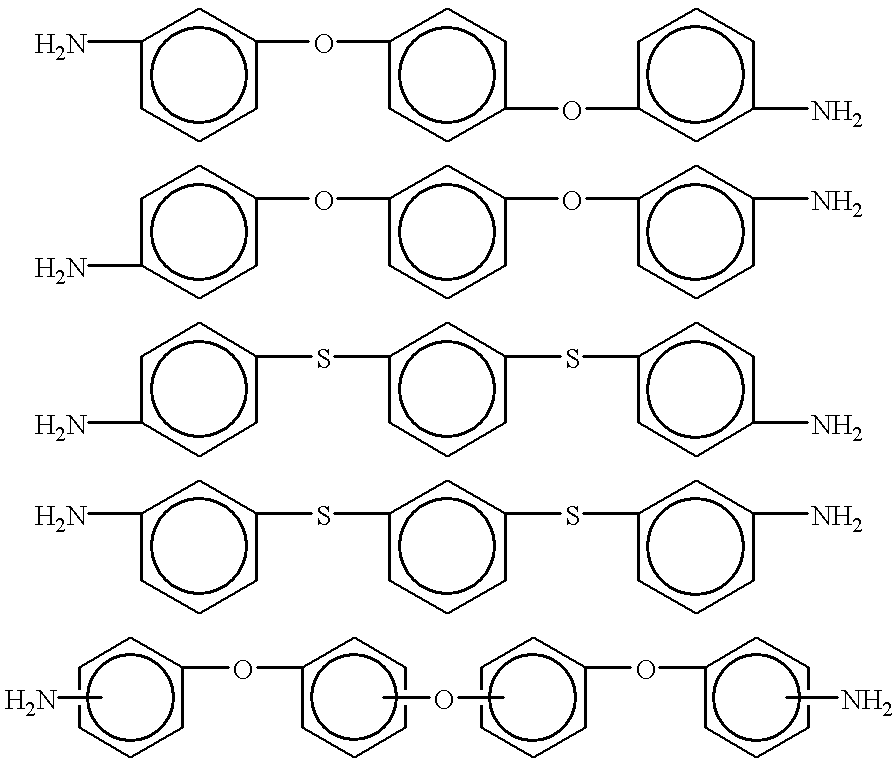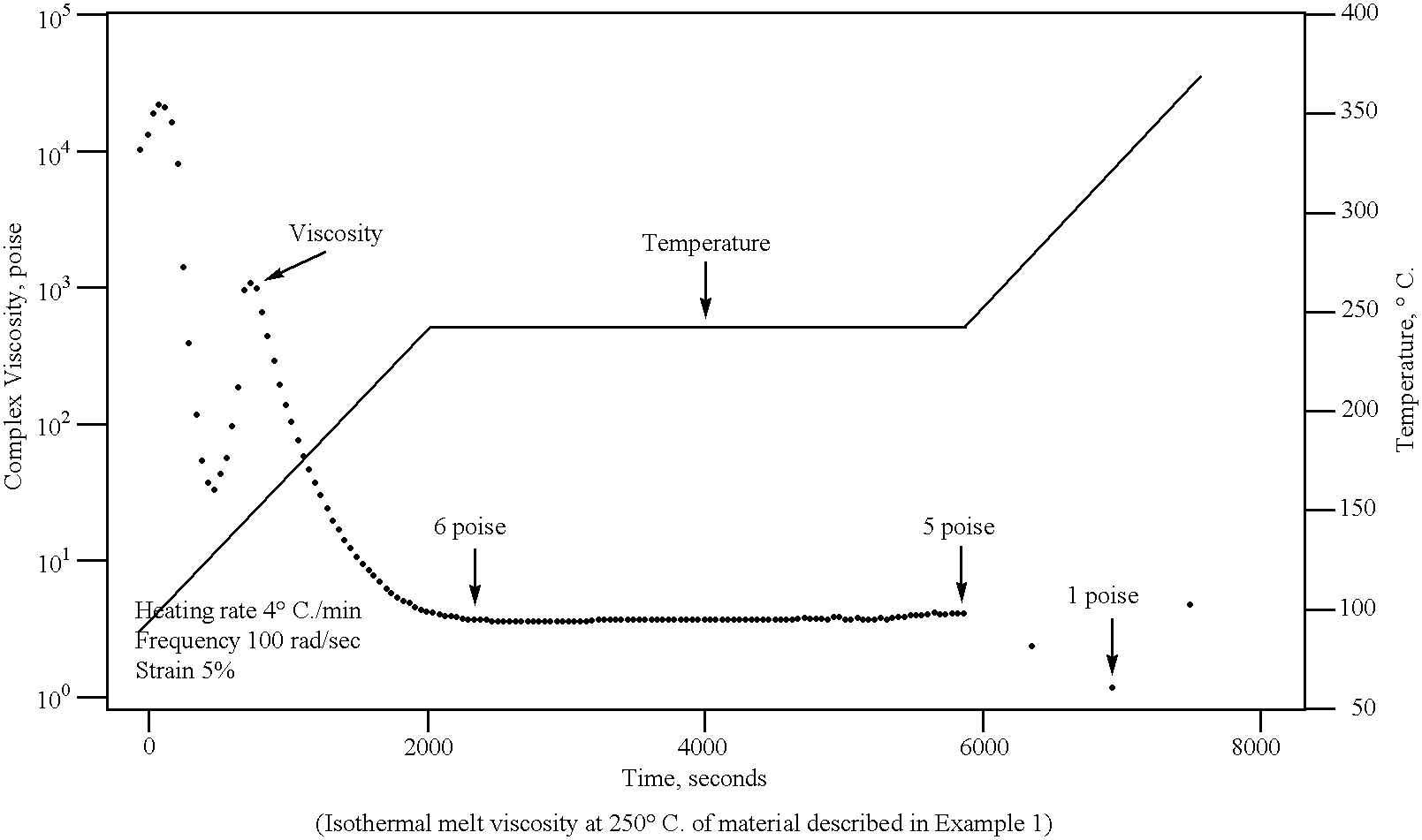Composition of and method for making high performance resins for infusion and transfer molding processes
- Summary
- Abstract
- Description
- Claims
- Application Information
AI Technical Summary
Benefits of technology
Problems solved by technology
Method used
Image
Examples
example 2
Synthesis of a phenylethynyl terminated amide acid and imnide co-oligomer with a calculated number average molecular weight of 1000 g / mole using 3,3',4,4'-biphenyltetracarboxylic dianhydride (BPDA, 0.58 mole), 1,3-bis(3-aminophenoxy)benzene (1,3-APB, 0.75 mole), 3,4'-oxydianiline (3,4'-ODA, 0.25 mole) and 4-phenylethynylphthalic anhydride (PEPA, 0.84 mole).
Into a 100 mL three neck round bottom flask equipped with a mechanical stirrer, thermometer and nitrogen inlet / outlet was placed 1,3-APB (4.6043 g, 0.01575 mole), 3,4'-ODA (1.05127 g, 0.00525 mole) and NMP (7 g). The mixture was stirred for .about.0.5-1 hr to dissolve the diamines. A slurry of BPDA (3.5836 g, 0.01218 mole) and PEPA (4.3789 g, 0.01764 mole) in NMP (10.6 g) was added. Additional NMP (10.0 g) was used to rinse in all of the anhydrides (30.0% solids w / w). Upon addition of the anhydride / NMP slurry, the reaction temperature increased slightly. The mixture was stirred overnight under nitrogen (all solids had dissolved at...
example 3
Synthesis of a phenylethynyl terminated amide acid and imide co-oligomer with a calculated number average molecular weight of 1250 g / mole using 3,3',4,4'- biphenyltetracarboxylic dianhydride (BPDA, 0.65 mole), 1,3-bis(3-aminophenoxyphenyl)benzene (1,3-APB, 0.75 mole), 3,4'-oxydianiline (3,4'-ODA, 0.25 mole) and 4-phenylethynylphthalic anhydride (PEPA, 0.70 mole).
Into a 4L reaction kettle equipped with a mechanical stirrer, thermometer and nitrogen inlet / outlet was placed 1,3-APB (658 g, 2.25 moles), 3,4'-ODA (150 g, 0.75 mole) and NMP (673 g). The mixture was stirred for .about.0.5-1 hr to dissolve the diamines. A slurry of BPDA (574 g, 1.95 mole) and PEPA (521 g, 2.1 mole) in NMP (1000 g) was added. Additional NMP (431 g) was used to rinse in all of the anhydrides (47.5% solids w / w). Upon addition of the anhydride / NMP slurry, the reaction temperature increased to .about.65.degree. C. The mixture was stirred for .about.4 hrs (all solids had not dissolved at this point), toluene was ...
example 4
Synthesis of an amide acid and imide co-oligomer containing both terminal and pendent phenylethynyl groups with a calculated number average molecular weight of 1250 g / mole using 3,3',4,4'-biphenyltetracarboxylic dianhydride (BPDA, 0.64 mole), 1,3-bis(3-aminophenoxyphenyl)benzene (1,3-APB, 0.75 mole), 3,4'-oxydianiline (3,4'-ODA, 0.20 mole), 3,5-diamino-4'-phenylethynyl benzophenone (DPEB, 0.05 mole) and 4-phenylethynylphthalic anhydride (PEPA, 0.68 mole).
Into a 100 mL three neck round bottom flask equipped with a mechanical stirrer, thermometer and nitrogen inlet / outlet was placed 1,3-APB (3.2888 g, 0.01125 mole), 3,4'-ODA (0.6007 g, 0.0030 mole), DPEB (0.2343 g, 0.00075 mole) and NMP (5.9 g). The mixture was stirred for .about.0.5-1 hr to dissolve the diamines. A slurry of BPDA (2.8245 g, 0.0096 mole) and PEPA (2.6809 g, 0.0108 mole) in NMP (10.0 g) was added. Additional NMP (4.0 g) was used to rinse in all of the anhydrides (32.6% solids w / w). Upon addition of the anhydride / NMP sl...
PUM
| Property | Measurement | Unit |
|---|---|---|
| Temperature | aaaaa | aaaaa |
| Angle | aaaaa | aaaaa |
| Melt viscosity | aaaaa | aaaaa |
Abstract
Description
Claims
Application Information
 Login to View More
Login to View More - R&D
- Intellectual Property
- Life Sciences
- Materials
- Tech Scout
- Unparalleled Data Quality
- Higher Quality Content
- 60% Fewer Hallucinations
Browse by: Latest US Patents, China's latest patents, Technical Efficacy Thesaurus, Application Domain, Technology Topic, Popular Technical Reports.
© 2025 PatSnap. All rights reserved.Legal|Privacy policy|Modern Slavery Act Transparency Statement|Sitemap|About US| Contact US: help@patsnap.com



